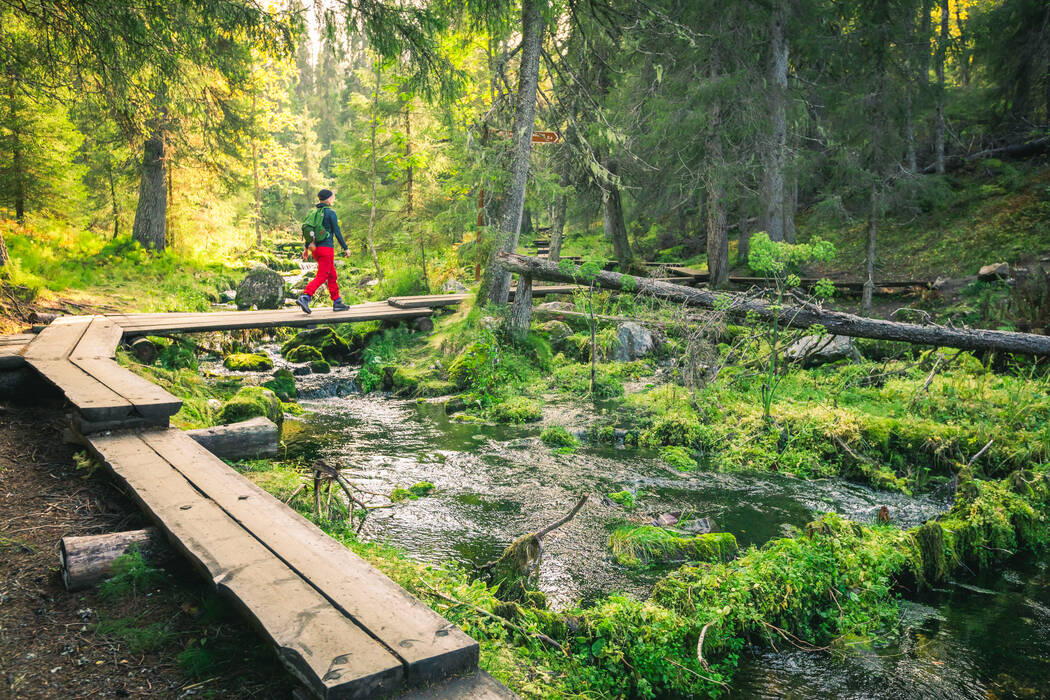There are several investment projects underway in Lapland with the aim of developing the recreational and outdoor infrastructure for visitors. The trails and other structures in national parks will be improved substantially, and ski resorts are investing in their slope operations: for example, Ylläs will offer an extended skiing season once its new snowmaking system is completed.
The increased popularity of hiking can also be seen in the investments in outdoor and recreational areas in Lapland. Metsähallitus (the state forest enterprise) received additional funding of 11 million euros for 2020–2021 from the government. The sum was allocated for the repair investments of Lapland’s natural attractions.
– For example, the visitor numbers of Lapland’s national parks have doubled in the last ten years. As a result, the need for wood and waste management and the maintenance of hiking structures has increased in equal proportions, says Jyrki Tolonen, Regional Manager of the Natural Heritage Service of Metsähallitus.
According to Tolonen, the increase in the visitor numbers of recreational areas is related to new user groups, among other factors. Groups such as families with children and young people have re-discovered hiking. New means of transport also inspire people to move about in nature.
– Two years ago, Metsähallitus opened the trails in the large national parks of Lapland to mountain bikers. It was a big deal and brought new visitors to the national parks.
The national parks located close to large resorts are particularly popular. Tolonen says that the recreational services and the tourism business have a functional symbiosis at these locations.
– In repair investments, our focus has been on the Pallas-Ylläs, Urho Kekkonen and Pyhä-Luosto national parks where there are significantly more visitors. When the infrastructure among nature is in order, customers are more comfortable and stay in the area longer. This way, the investments also support the business life of the area.
In addition to national parks, Metsähallitus has also improved the recreational services in the local destinations in population centers. For example, the Arctic Circle Hiking Area in Rovaniemi, which doubled its visitor numbers in just a few years, has focused on accessibility. Similarly, the Juutuanpolku recreational route in Inari was reinforced and illuminated in cooperation with the municipality.
In addition to this, many municipalities in Lapland are developing their own local recreational areas, making use of the funding of over half a million euros granted to Lapland by the Ministry of the Environment in the spring.
A new national park to be founded in Salla
Lapland will have a new national park if the Finnish Parliament approves the act on Salla National Park. If realized, Salla National Park would cover a little under 10,000 hectares and complement the wide variety of national parks in Lapland.
Typical characteristics of the future national park include old protected forests, aapa mires, individual fells, and terrain shaped by the ice age. The old natural forests over 400 meters above sea level make the area unique. The eastern border connects the area to the Russian forests and the species of the east, which would form a large entity with the nature conservation network across the border.
The government proposal for the Salla National Park project was circulated for comments early this year. Local and other stakeholders have a positive outlook on the founding of the park.
– Salla National Park would increase the region’s appeal and strengthen the local economy by bringing in new customers and prolonging their stays, Jyrki Tolonen says.
According to Tolonen, experience has shown that the impact on visitor numbers can be seen shortly after the founding of a national park. This was seen a few years ago in Hossa, for example, where the visitor numbers of the hiking area doubled the year following the establishment of a national park.
– The improvements on the trails and other services will start as soon as the bill on Salla National Park is passed. Based on the bill circulated, we hope to receive at least 2.5 million euros from the government to establish the park and improve its infrastructure. The National Park may enter the founding stage during this year.

Investments in developing the slope operations
The slope infrastructure vital for the winter tourism in Lapland will be developed in multiple destinations next year, including Ylläs and Pyhä.
On the Pyhä Fell, the construction of the PohjoisExpress chairlift is about to begin now that the snows have melted. This new and faster lift will be ready for use the next winter season.
In Ylläs, Sport Resort Ylläs is investing three million euros in developing its slope services this year. The most significant part of the investment project is a fully automatic snowmaking system built in the gondola slope, which will increase the certainty of snow for the slope that has previously depended on natural snow.
– The gondola slope is one of the main slopes in Ylläs, and we have usually been able to open it to the public only in early February, depending on the winter in question. Thanks to the new snowmaking system, we can start using the slope up to two months earlier, which helps offer our customers better skiing experiences, says CEO of Sport Resort Ylläs Mikko Virranniemi.
The operating hours of the gondola slope will be further increased by the LED lights to be built, which will allow people to ski from morning to evening, even during the polar night.
For slope maintenance, Ylläs will be using a hybrid machine next winter. Its fuel consumption, carbon dioxide emissions and noise levels are all lower, which is in line with the Sport Resort’s aims to reduce its carbon footprint. From the start of this year, Sport Resort Ylläs moved to using 100% renewable energy. Virranniemi says that environmental matters will also be taken into account in all of the ski resort’s investments in the future.



